Financial Report: Innocent Drinks UK - Management Accounting Analysis
VerifiedAdded on 2022/10/12
|25
|5377
|39
Report
AI Summary
This report provides a detailed exploration of management accounting principles and their practical applications. Part 1 defines management and financial accounting, comparing their systems and outlining various types of management accounting systems such as cost accounting, inventory management, and job-costing systems. It also covers different reporting methods including job cost reports, performance reports, and variance analysis. Part 2 focuses on a case study of Innocent Drinks UK, applying absorption and marginal costing methods to prepare income statements. It includes calculations for full production costs, inventory valuation, and profit reconciliation. Furthermore, the report delves into break-even analysis, margin of safety calculations, and graphical representations. It also discusses budgetary control tools, including zero-based, activity-based, and incremental budgeting, alongside adaptations of management accounting systems like the Balanced Scorecard and benchmarking. The report concludes by assessing the significance of management accounting in modern organizations, emphasizing its advantages in strategic decision-making and performance improvement.

Contents
Page
Introduction 3
Part 1:
Management Accounting 4
Financial Accounting 4
A comparison between management and financial accounting systems 4
Types of management accounting systems 5
Cost Accounting 5
Benefits of cost accounting: 5
Inventory Management System 5
Benefits of Inventory System 5
Job-costing systems 5
Issues with Job-costing systems 6
Price-optimizing systems 6
Benefits of price-optimizing systems 6
Different Methods used for Management Accounting Reporting 6
Job Cost Reports 6
Inventory Management Reports 7
Performance Reports 7
Variance Report 7
A Profit and Loss Report (P&L) 7
The Cash Flow Statement 8
Customer Survey Reports 8
Part 2:
Innocent Drinks UK -
Prepare an Income Statement using Marginal and Absorption Costing 9
1.1
Absorption Costing 9
W1 Calculation of full production cost 9
W2 Calculation of value of inventory and production (valued at £8 per unit) 9
W3 Under/over absorbed fixed production overhead 10
Absorption costing profit statement 10
Net Profit 10
Marginal Costing 11
W1 Variable production cost 11
W2 Value of Inventory and production 11
Marginal costing profit statement 11
Net Profit 12
Reconciliation of profit figures 13
1.2 INNOCENT DRINKS UK - DAIRY FREE RANGE OF DRINKS
a). Break-Even Point for the next year 14
b). Margin of Safety for next year – Expressed in Quantity and Sales Value 15
c). Break Even Point using Graphical Method 16
0
Page
Introduction 3
Part 1:
Management Accounting 4
Financial Accounting 4
A comparison between management and financial accounting systems 4
Types of management accounting systems 5
Cost Accounting 5
Benefits of cost accounting: 5
Inventory Management System 5
Benefits of Inventory System 5
Job-costing systems 5
Issues with Job-costing systems 6
Price-optimizing systems 6
Benefits of price-optimizing systems 6
Different Methods used for Management Accounting Reporting 6
Job Cost Reports 6
Inventory Management Reports 7
Performance Reports 7
Variance Report 7
A Profit and Loss Report (P&L) 7
The Cash Flow Statement 8
Customer Survey Reports 8
Part 2:
Innocent Drinks UK -
Prepare an Income Statement using Marginal and Absorption Costing 9
1.1
Absorption Costing 9
W1 Calculation of full production cost 9
W2 Calculation of value of inventory and production (valued at £8 per unit) 9
W3 Under/over absorbed fixed production overhead 10
Absorption costing profit statement 10
Net Profit 10
Marginal Costing 11
W1 Variable production cost 11
W2 Value of Inventory and production 11
Marginal costing profit statement 11
Net Profit 12
Reconciliation of profit figures 13
1.2 INNOCENT DRINKS UK - DAIRY FREE RANGE OF DRINKS
a). Break-Even Point for the next year 14
b). Margin of Safety for next year – Expressed in Quantity and Sales Value 15
c). Break Even Point using Graphical Method 16
0
Paraphrase This Document
Need a fresh take? Get an instant paraphrase of this document with our AI Paraphraser
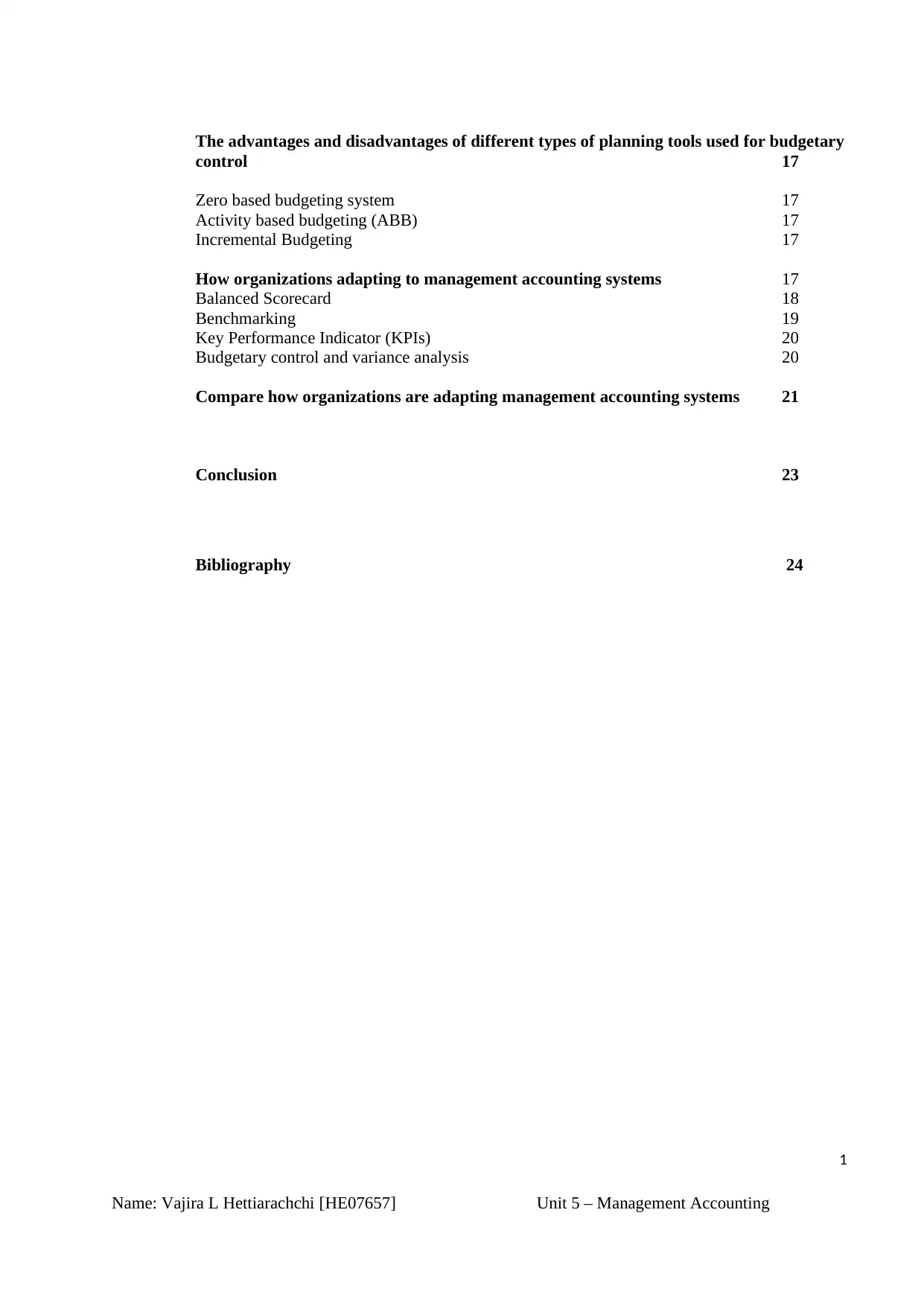
The advantages and disadvantages of different types of planning tools used for budgetary
control 17
Zero based budgeting system 17
Activity based budgeting (ABB) 17
Incremental Budgeting 17
How organizations adapting to management accounting systems 17
Balanced Scorecard 18
Benchmarking 19
Key Performance Indicator (KPIs) 20
Budgetary control and variance analysis 20
Compare how organizations are adapting management accounting systems 21
Conclusion 23
Bibliography 24
Name: Vajira L Hettiarachchi [HE07657] Unit 5 – Management Accounting
1
control 17
Zero based budgeting system 17
Activity based budgeting (ABB) 17
Incremental Budgeting 17
How organizations adapting to management accounting systems 17
Balanced Scorecard 18
Benchmarking 19
Key Performance Indicator (KPIs) 20
Budgetary control and variance analysis 20
Compare how organizations are adapting management accounting systems 21
Conclusion 23
Bibliography 24
Name: Vajira L Hettiarachchi [HE07657] Unit 5 – Management Accounting
1
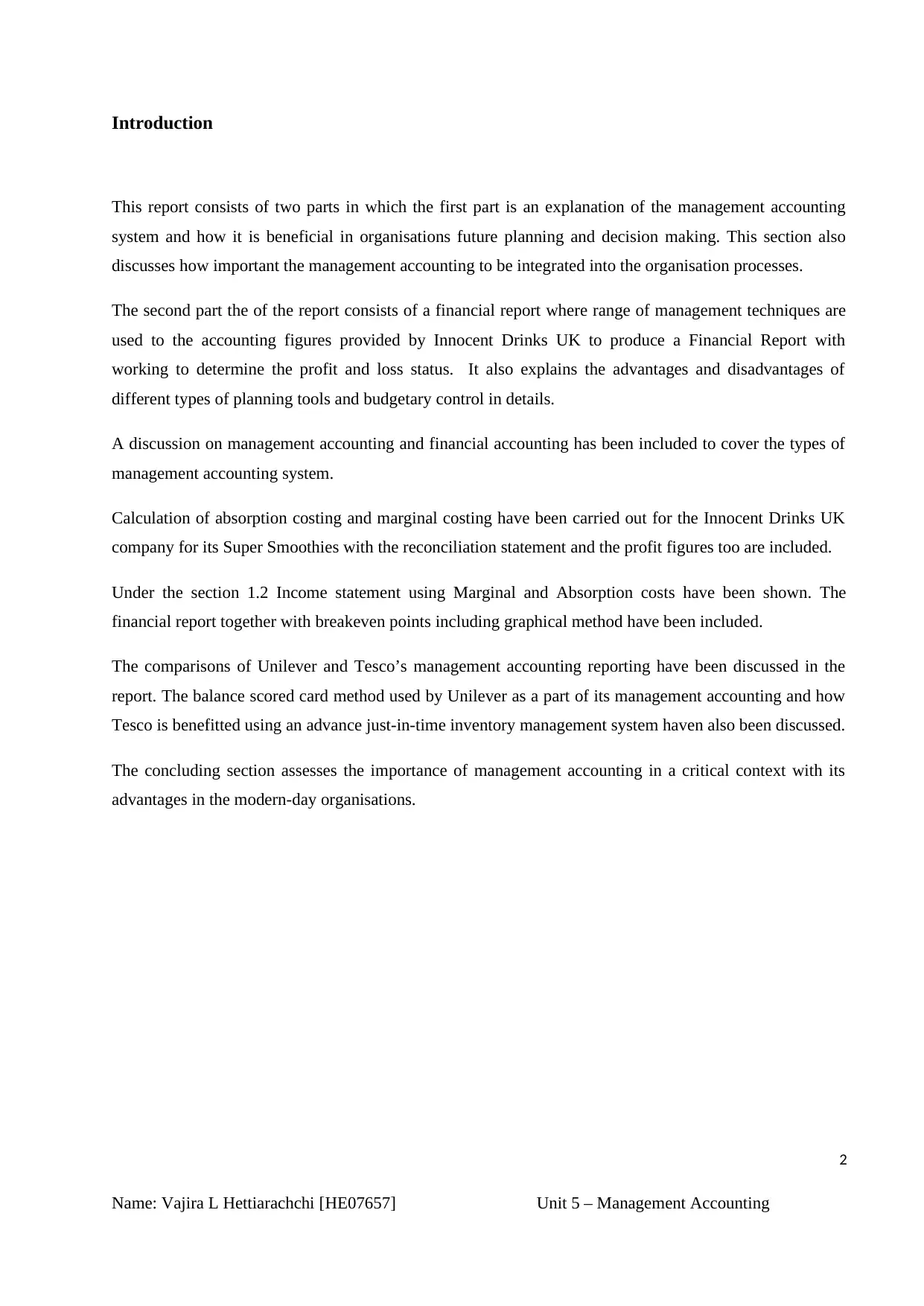
Introduction
This report consists of two parts in which the first part is an explanation of the management accounting
system and how it is beneficial in organisations future planning and decision making. This section also
discusses how important the management accounting to be integrated into the organisation processes.
The second part the of the report consists of a financial report where range of management techniques are
used to the accounting figures provided by Innocent Drinks UK to produce a Financial Report with
working to determine the profit and loss status. It also explains the advantages and disadvantages of
different types of planning tools and budgetary control in details.
A discussion on management accounting and financial accounting has been included to cover the types of
management accounting system.
Calculation of absorption costing and marginal costing have been carried out for the Innocent Drinks UK
company for its Super Smoothies with the reconciliation statement and the profit figures too are included.
Under the section 1.2 Income statement using Marginal and Absorption costs have been shown. The
financial report together with breakeven points including graphical method have been included.
The comparisons of Unilever and Tesco’s management accounting reporting have been discussed in the
report. The balance scored card method used by Unilever as a part of its management accounting and how
Tesco is benefitted using an advance just-in-time inventory management system haven also been discussed.
The concluding section assesses the importance of management accounting in a critical context with its
advantages in the modern-day organisations.
Name: Vajira L Hettiarachchi [HE07657] Unit 5 – Management Accounting
2
This report consists of two parts in which the first part is an explanation of the management accounting
system and how it is beneficial in organisations future planning and decision making. This section also
discusses how important the management accounting to be integrated into the organisation processes.
The second part the of the report consists of a financial report where range of management techniques are
used to the accounting figures provided by Innocent Drinks UK to produce a Financial Report with
working to determine the profit and loss status. It also explains the advantages and disadvantages of
different types of planning tools and budgetary control in details.
A discussion on management accounting and financial accounting has been included to cover the types of
management accounting system.
Calculation of absorption costing and marginal costing have been carried out for the Innocent Drinks UK
company for its Super Smoothies with the reconciliation statement and the profit figures too are included.
Under the section 1.2 Income statement using Marginal and Absorption costs have been shown. The
financial report together with breakeven points including graphical method have been included.
The comparisons of Unilever and Tesco’s management accounting reporting have been discussed in the
report. The balance scored card method used by Unilever as a part of its management accounting and how
Tesco is benefitted using an advance just-in-time inventory management system haven also been discussed.
The concluding section assesses the importance of management accounting in a critical context with its
advantages in the modern-day organisations.
Name: Vajira L Hettiarachchi [HE07657] Unit 5 – Management Accounting
2
⊘ This is a preview!⊘
Do you want full access?
Subscribe today to unlock all pages.

Trusted by 1+ million students worldwide

Part 1:
Management Accounting:
Management accounting is defined as a process of identification, analysis, preparation, communication
and interpretation of both qualitative and quantitative data provided to managers within the organization so
that they could take strategical decisions as well as control day to day operations. (Burns, et.al.2013).
The management accounting information helps the internal managers of the organization, its employees
and senior executives in decision making and to improve performance. The future success of an
organization depends on information provided in the management accounting reports. Also, these
management accounting reports enhance both customer and shareholder value (researchgate,2018).
Financial Accounting :
This is a branch of accounting in which financial statements are produced of the transactions made to
show its financial position to the people outside the company. These people may include investors,
suppliers, creditors and customers. Producing financial account statements is also a regulatory requirement
that all companies and organizations must adhered to. There are several main functions of financial
accounting and these include, budget preparation, planning, cost control and prevention of fraud.
(Financial accounting and reporting, 2019)
A comparison between management and financial accounting systems.
.
Management Accounting Financial Accounting
Detailed information relating to department,
product, customer and employees are needed.
Only the summarized data is required.
Not mandatory. Mandatory as external customers could be waiting
for it.
Need to follow the accepted accounting rules. Need to follow the accepted accounting rules.
Information is bound by the time period. Precision past performance information is
required.
Name: Vajira L Hettiarachchi [HE07657] Unit 5 – Management Accounting
3
Management Accounting:
Management accounting is defined as a process of identification, analysis, preparation, communication
and interpretation of both qualitative and quantitative data provided to managers within the organization so
that they could take strategical decisions as well as control day to day operations. (Burns, et.al.2013).
The management accounting information helps the internal managers of the organization, its employees
and senior executives in decision making and to improve performance. The future success of an
organization depends on information provided in the management accounting reports. Also, these
management accounting reports enhance both customer and shareholder value (researchgate,2018).
Financial Accounting :
This is a branch of accounting in which financial statements are produced of the transactions made to
show its financial position to the people outside the company. These people may include investors,
suppliers, creditors and customers. Producing financial account statements is also a regulatory requirement
that all companies and organizations must adhered to. There are several main functions of financial
accounting and these include, budget preparation, planning, cost control and prevention of fraud.
(Financial accounting and reporting, 2019)
A comparison between management and financial accounting systems.
.
Management Accounting Financial Accounting
Detailed information relating to department,
product, customer and employees are needed.
Only the summarized data is required.
Not mandatory. Mandatory as external customers could be waiting
for it.
Need to follow the accepted accounting rules. Need to follow the accepted accounting rules.
Information is bound by the time period. Precision past performance information is
required.
Name: Vajira L Hettiarachchi [HE07657] Unit 5 – Management Accounting
3
Paraphrase This Document
Need a fresh take? Get an instant paraphrase of this document with our AI Paraphraser
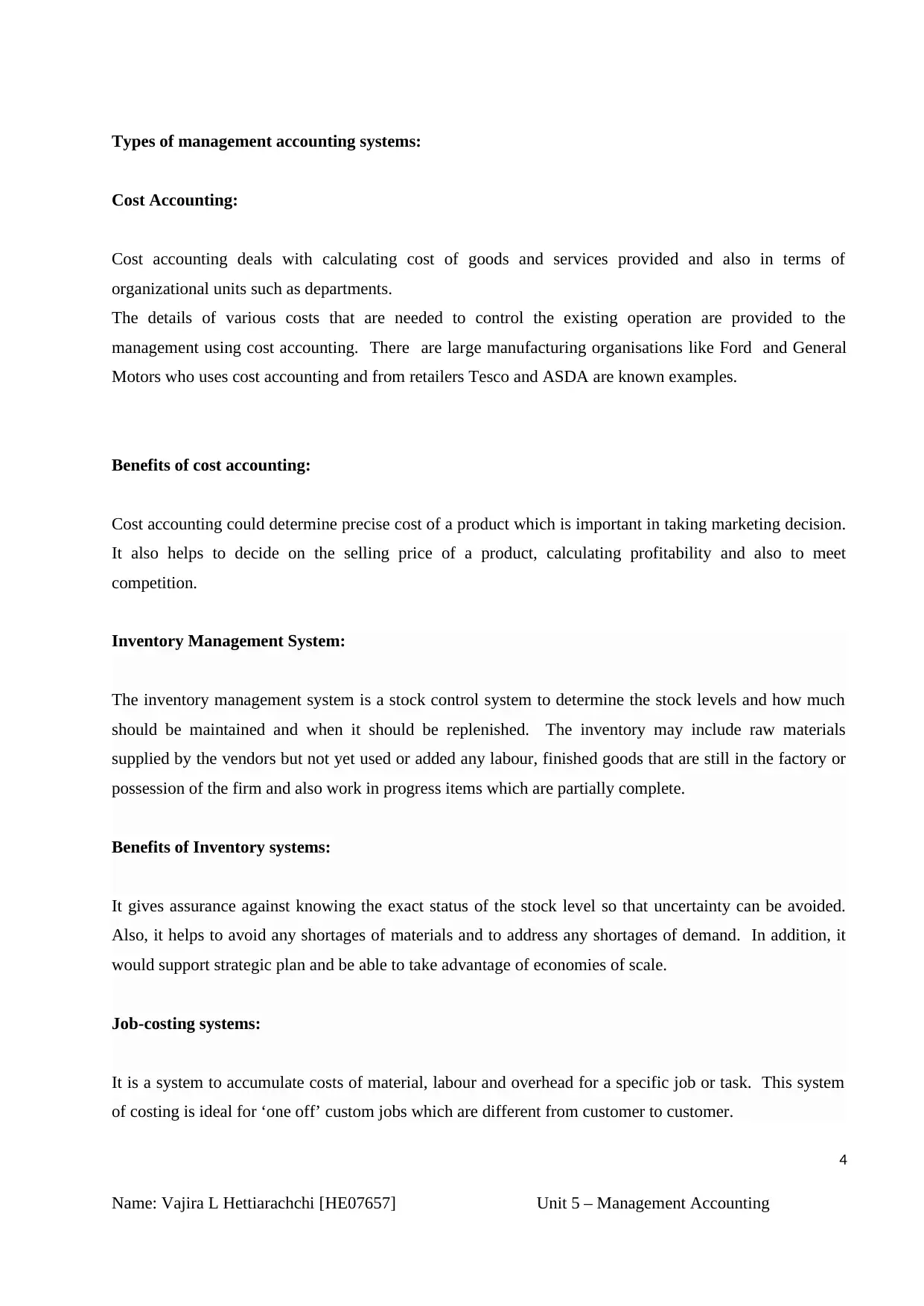
Types of management accounting systems:
Cost Accounting:
Cost accounting deals with calculating cost of goods and services provided and also in terms of
organizational units such as departments.
The details of various costs that are needed to control the existing operation are provided to the
management using cost accounting. There are large manufacturing organisations like Ford and General
Motors who uses cost accounting and from retailers Tesco and ASDA are known examples.
Benefits of cost accounting:
Cost accounting could determine precise cost of a product which is important in taking marketing decision.
It also helps to decide on the selling price of a product, calculating profitability and also to meet
competition.
Inventory Management System:
The inventory management system is a stock control system to determine the stock levels and how much
should be maintained and when it should be replenished. The inventory may include raw materials
supplied by the vendors but not yet used or added any labour, finished goods that are still in the factory or
possession of the firm and also work in progress items which are partially complete.
Benefits of Inventory systems:
It gives assurance against knowing the exact status of the stock level so that uncertainty can be avoided.
Also, it helps to avoid any shortages of materials and to address any shortages of demand. In addition, it
would support strategic plan and be able to take advantage of economies of scale.
Job-costing systems:
It is a system to accumulate costs of material, labour and overhead for a specific job or task. This system
of costing is ideal for ‘one off’ custom jobs which are different from customer to customer.
Name: Vajira L Hettiarachchi [HE07657] Unit 5 – Management Accounting
4
Cost Accounting:
Cost accounting deals with calculating cost of goods and services provided and also in terms of
organizational units such as departments.
The details of various costs that are needed to control the existing operation are provided to the
management using cost accounting. There are large manufacturing organisations like Ford and General
Motors who uses cost accounting and from retailers Tesco and ASDA are known examples.
Benefits of cost accounting:
Cost accounting could determine precise cost of a product which is important in taking marketing decision.
It also helps to decide on the selling price of a product, calculating profitability and also to meet
competition.
Inventory Management System:
The inventory management system is a stock control system to determine the stock levels and how much
should be maintained and when it should be replenished. The inventory may include raw materials
supplied by the vendors but not yet used or added any labour, finished goods that are still in the factory or
possession of the firm and also work in progress items which are partially complete.
Benefits of Inventory systems:
It gives assurance against knowing the exact status of the stock level so that uncertainty can be avoided.
Also, it helps to avoid any shortages of materials and to address any shortages of demand. In addition, it
would support strategic plan and be able to take advantage of economies of scale.
Job-costing systems:
It is a system to accumulate costs of material, labour and overhead for a specific job or task. This system
of costing is ideal for ‘one off’ custom jobs which are different from customer to customer.
Name: Vajira L Hettiarachchi [HE07657] Unit 5 – Management Accounting
4
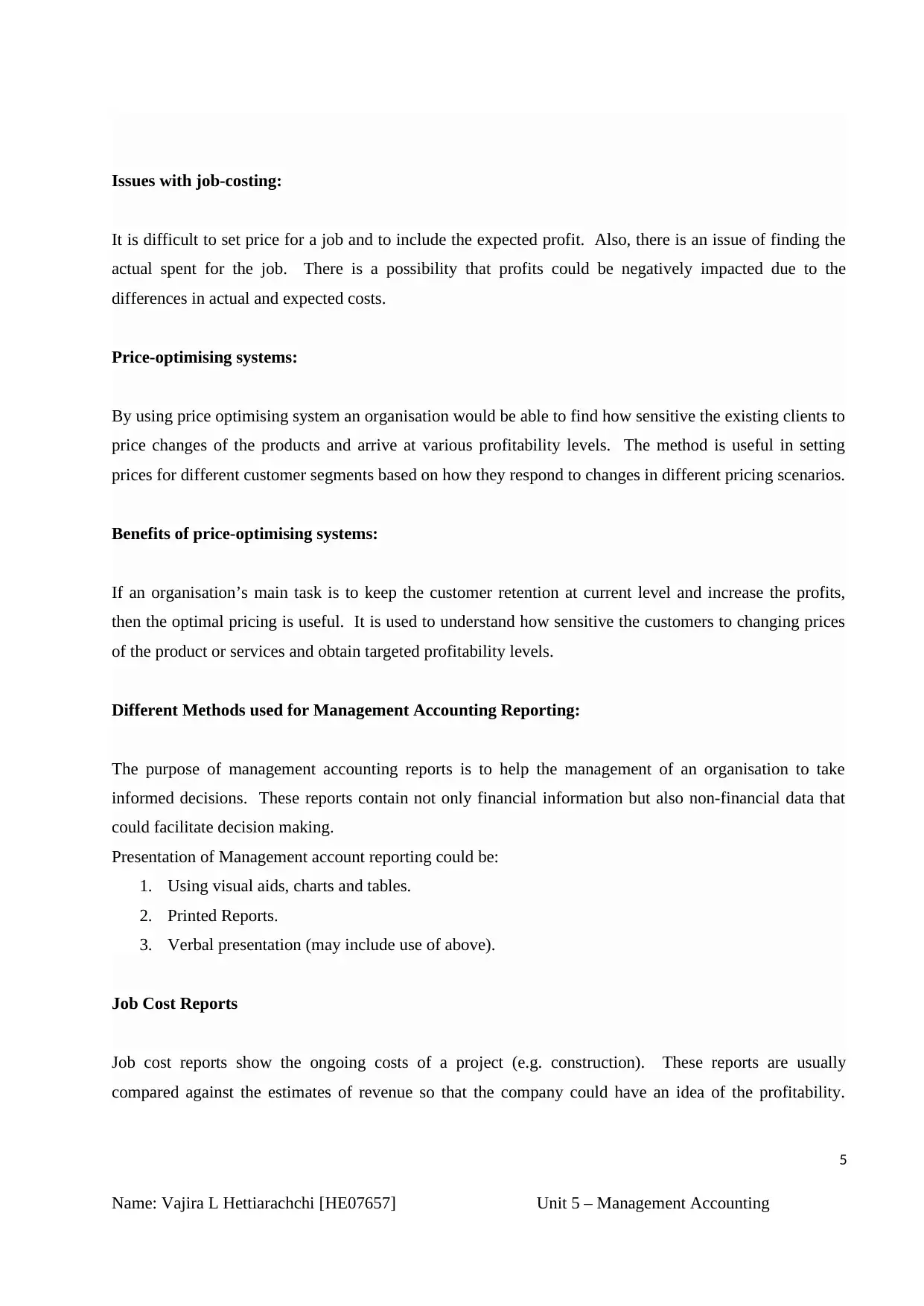
Issues with job-costing:
It is difficult to set price for a job and to include the expected profit. Also, there is an issue of finding the
actual spent for the job. There is a possibility that profits could be negatively impacted due to the
differences in actual and expected costs.
Price-optimising systems:
By using price optimising system an organisation would be able to find how sensitive the existing clients to
price changes of the products and arrive at various profitability levels. The method is useful in setting
prices for different customer segments based on how they respond to changes in different pricing scenarios.
Benefits of price-optimising systems:
If an organisation’s main task is to keep the customer retention at current level and increase the profits,
then the optimal pricing is useful. It is used to understand how sensitive the customers to changing prices
of the product or services and obtain targeted profitability levels.
Different Methods used for Management Accounting Reporting:
The purpose of management accounting reports is to help the management of an organisation to take
informed decisions. These reports contain not only financial information but also non-financial data that
could facilitate decision making.
Presentation of Management account reporting could be:
1. Using visual aids, charts and tables.
2. Printed Reports.
3. Verbal presentation (may include use of above).
Job Cost Reports
Job cost reports show the ongoing costs of a project (e.g. construction). These reports are usually
compared against the estimates of revenue so that the company could have an idea of the profitability.
Name: Vajira L Hettiarachchi [HE07657] Unit 5 – Management Accounting
5
It is difficult to set price for a job and to include the expected profit. Also, there is an issue of finding the
actual spent for the job. There is a possibility that profits could be negatively impacted due to the
differences in actual and expected costs.
Price-optimising systems:
By using price optimising system an organisation would be able to find how sensitive the existing clients to
price changes of the products and arrive at various profitability levels. The method is useful in setting
prices for different customer segments based on how they respond to changes in different pricing scenarios.
Benefits of price-optimising systems:
If an organisation’s main task is to keep the customer retention at current level and increase the profits,
then the optimal pricing is useful. It is used to understand how sensitive the customers to changing prices
of the product or services and obtain targeted profitability levels.
Different Methods used for Management Accounting Reporting:
The purpose of management accounting reports is to help the management of an organisation to take
informed decisions. These reports contain not only financial information but also non-financial data that
could facilitate decision making.
Presentation of Management account reporting could be:
1. Using visual aids, charts and tables.
2. Printed Reports.
3. Verbal presentation (may include use of above).
Job Cost Reports
Job cost reports show the ongoing costs of a project (e.g. construction). These reports are usually
compared against the estimates of revenue so that the company could have an idea of the profitability.
Name: Vajira L Hettiarachchi [HE07657] Unit 5 – Management Accounting
5
⊘ This is a preview!⊘
Do you want full access?
Subscribe today to unlock all pages.

Trusted by 1+ million students worldwide
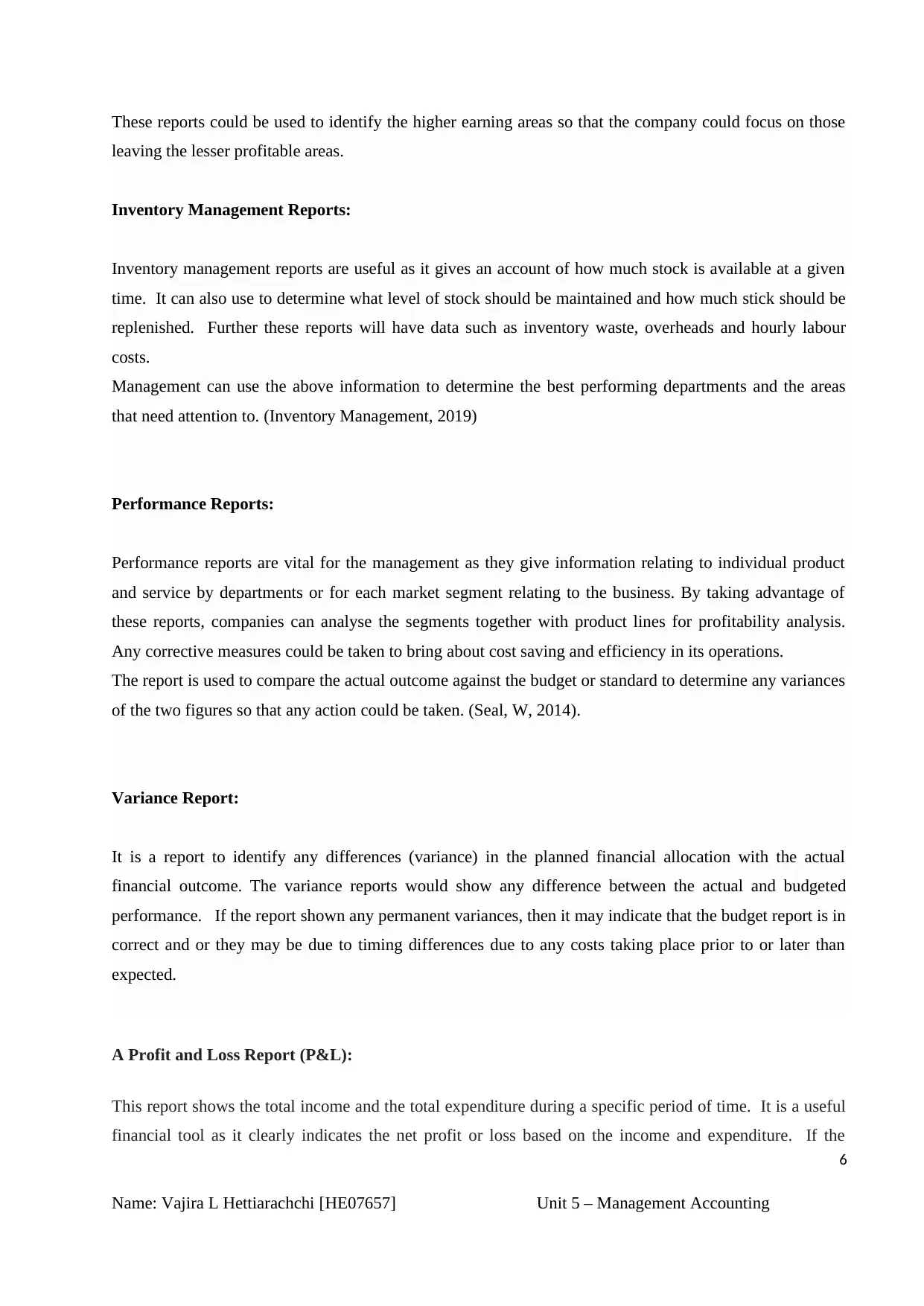
These reports could be used to identify the higher earning areas so that the company could focus on those
leaving the lesser profitable areas.
Inventory Management Reports:
Inventory management reports are useful as it gives an account of how much stock is available at a given
time. It can also use to determine what level of stock should be maintained and how much stick should be
replenished. Further these reports will have data such as inventory waste, overheads and hourly labour
costs.
Management can use the above information to determine the best performing departments and the areas
that need attention to. (Inventory Management, 2019)
Performance Reports:
Performance reports are vital for the management as they give information relating to individual product
and service by departments or for each market segment relating to the business. By taking advantage of
these reports, companies can analyse the segments together with product lines for profitability analysis.
Any corrective measures could be taken to bring about cost saving and efficiency in its operations.
The report is used to compare the actual outcome against the budget or standard to determine any variances
of the two figures so that any action could be taken. (Seal, W, 2014).
Variance Report:
It is a report to identify any differences (variance) in the planned financial allocation with the actual
financial outcome. The variance reports would show any difference between the actual and budgeted
performance. If the report shown any permanent variances, then it may indicate that the budget report is in
correct and or they may be due to timing differences due to any costs taking place prior to or later than
expected.
A Profit and Loss Report (P&L):
This report shows the total income and the total expenditure during a specific period of time. It is a useful
financial tool as it clearly indicates the net profit or loss based on the income and expenditure. If the
Name: Vajira L Hettiarachchi [HE07657] Unit 5 – Management Accounting
6
leaving the lesser profitable areas.
Inventory Management Reports:
Inventory management reports are useful as it gives an account of how much stock is available at a given
time. It can also use to determine what level of stock should be maintained and how much stick should be
replenished. Further these reports will have data such as inventory waste, overheads and hourly labour
costs.
Management can use the above information to determine the best performing departments and the areas
that need attention to. (Inventory Management, 2019)
Performance Reports:
Performance reports are vital for the management as they give information relating to individual product
and service by departments or for each market segment relating to the business. By taking advantage of
these reports, companies can analyse the segments together with product lines for profitability analysis.
Any corrective measures could be taken to bring about cost saving and efficiency in its operations.
The report is used to compare the actual outcome against the budget or standard to determine any variances
of the two figures so that any action could be taken. (Seal, W, 2014).
Variance Report:
It is a report to identify any differences (variance) in the planned financial allocation with the actual
financial outcome. The variance reports would show any difference between the actual and budgeted
performance. If the report shown any permanent variances, then it may indicate that the budget report is in
correct and or they may be due to timing differences due to any costs taking place prior to or later than
expected.
A Profit and Loss Report (P&L):
This report shows the total income and the total expenditure during a specific period of time. It is a useful
financial tool as it clearly indicates the net profit or loss based on the income and expenditure. If the
Name: Vajira L Hettiarachchi [HE07657] Unit 5 – Management Accounting
6
Paraphrase This Document
Need a fresh take? Get an instant paraphrase of this document with our AI Paraphraser
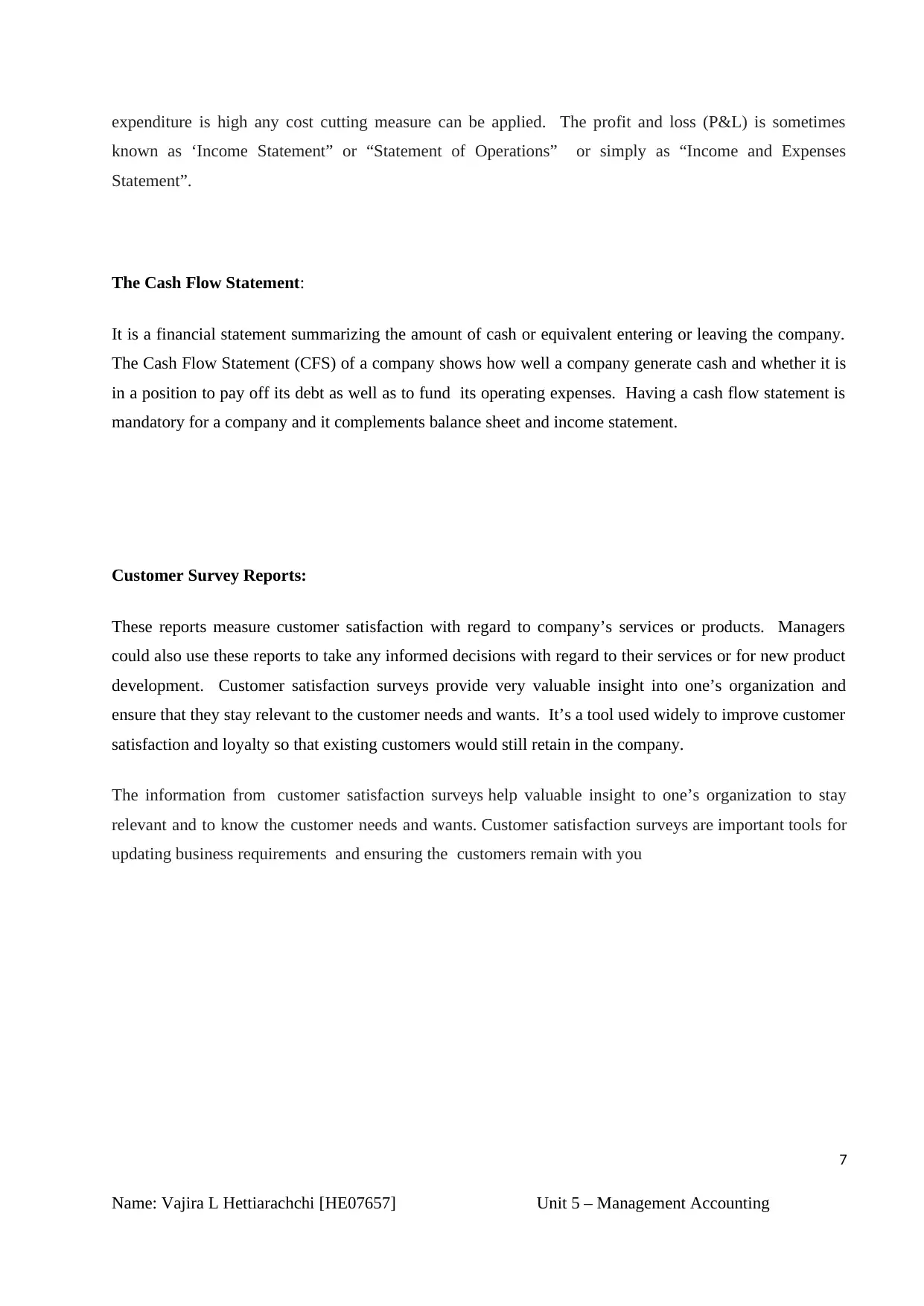
expenditure is high any cost cutting measure can be applied. The profit and loss (P&L) is sometimes
known as ‘Income Statement” or “Statement of Operations” or simply as “Income and Expenses
Statement”.
The Cash Flow Statement:
It is a financial statement summarizing the amount of cash or equivalent entering or leaving the company.
The Cash Flow Statement (CFS) of a company shows how well a company generate cash and whether it is
in a position to pay off its debt as well as to fund its operating expenses. Having a cash flow statement is
mandatory for a company and it complements balance sheet and income statement.
Customer Survey Reports:
These reports measure customer satisfaction with regard to company’s services or products. Managers
could also use these reports to take any informed decisions with regard to their services or for new product
development. Customer satisfaction surveys provide very valuable insight into one’s organization and
ensure that they stay relevant to the customer needs and wants. It’s a tool used widely to improve customer
satisfaction and loyalty so that existing customers would still retain in the company.
The information from customer satisfaction surveys help valuable insight to one’s organization to stay
relevant and to know the customer needs and wants. Customer satisfaction surveys are important tools for
updating business requirements and ensuring the customers remain with you
Name: Vajira L Hettiarachchi [HE07657] Unit 5 – Management Accounting
7
known as ‘Income Statement” or “Statement of Operations” or simply as “Income and Expenses
Statement”.
The Cash Flow Statement:
It is a financial statement summarizing the amount of cash or equivalent entering or leaving the company.
The Cash Flow Statement (CFS) of a company shows how well a company generate cash and whether it is
in a position to pay off its debt as well as to fund its operating expenses. Having a cash flow statement is
mandatory for a company and it complements balance sheet and income statement.
Customer Survey Reports:
These reports measure customer satisfaction with regard to company’s services or products. Managers
could also use these reports to take any informed decisions with regard to their services or for new product
development. Customer satisfaction surveys provide very valuable insight into one’s organization and
ensure that they stay relevant to the customer needs and wants. It’s a tool used widely to improve customer
satisfaction and loyalty so that existing customers would still retain in the company.
The information from customer satisfaction surveys help valuable insight to one’s organization to stay
relevant and to know the customer needs and wants. Customer satisfaction surveys are important tools for
updating business requirements and ensuring the customers remain with you
Name: Vajira L Hettiarachchi [HE07657] Unit 5 – Management Accounting
7
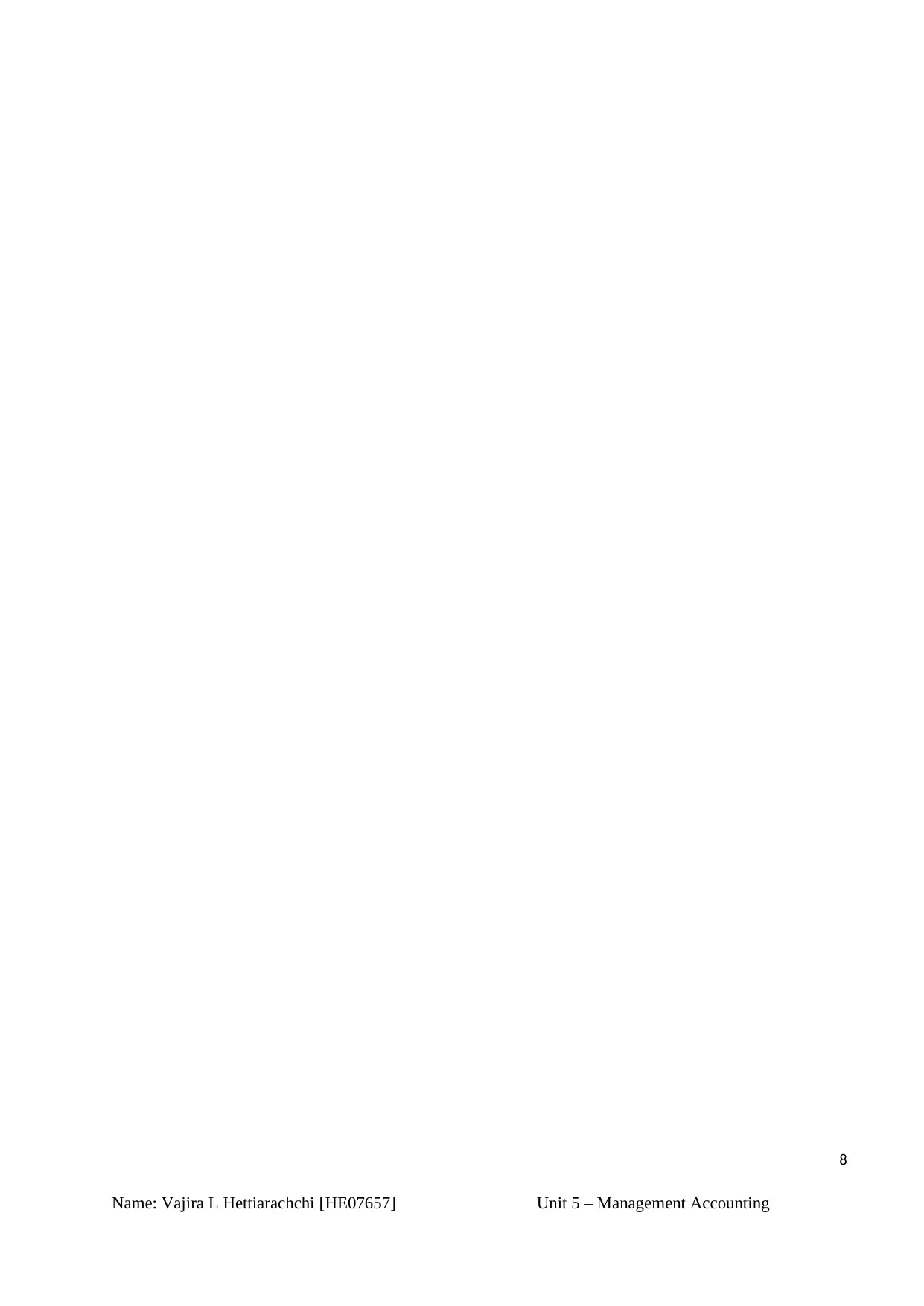
Name: Vajira L Hettiarachchi [HE07657] Unit 5 – Management Accounting
8
8
⊘ This is a preview!⊘
Do you want full access?
Subscribe today to unlock all pages.

Trusted by 1+ million students worldwide
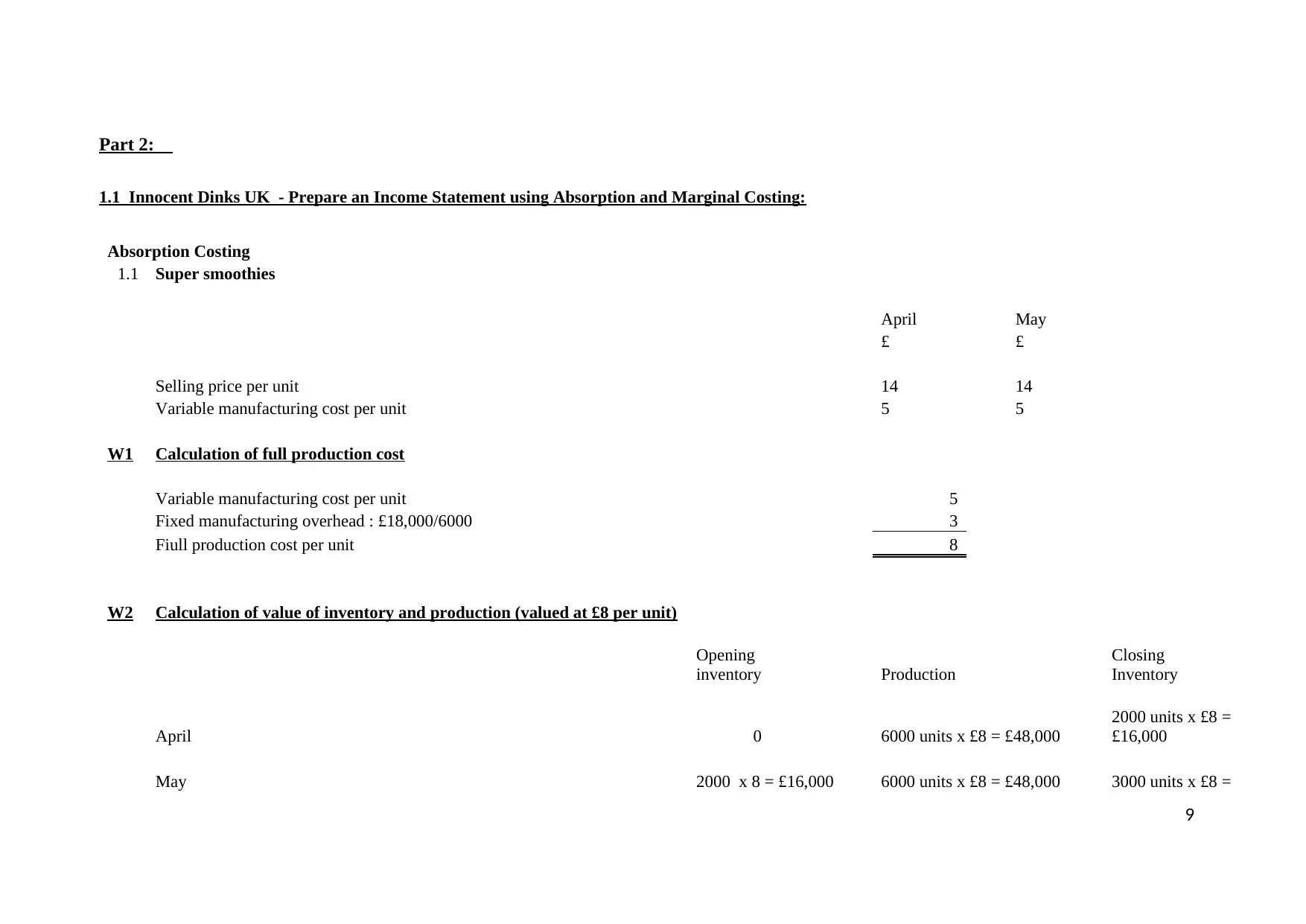
Part 2:
1.1 Innocent Dinks UK - Prepare an Income Statement using Absorption and Marginal Costing:
Absorption Costing
1.1 Super smoothies
April May
£ £
Selling price per unit 14 14
Variable manufacturing cost per unit 5 5
W1 Calculation of full production cost
Variable manufacturing cost per unit 5
Fixed manufacturing overhead : £18,000/6000 3
Fiull production cost per unit 8
W2 Calculation of value of inventory and production (valued at £8 per unit)
Opening
inventory Production
Closing
Inventory
April 0 6000 units x £8 = £48,000
2000 units x £8 =
£16,000
May 2000 x 8 = £16,000 6000 units x £8 = £48,000 3000 units x £8 =
9
1.1 Innocent Dinks UK - Prepare an Income Statement using Absorption and Marginal Costing:
Absorption Costing
1.1 Super smoothies
April May
£ £
Selling price per unit 14 14
Variable manufacturing cost per unit 5 5
W1 Calculation of full production cost
Variable manufacturing cost per unit 5
Fixed manufacturing overhead : £18,000/6000 3
Fiull production cost per unit 8
W2 Calculation of value of inventory and production (valued at £8 per unit)
Opening
inventory Production
Closing
Inventory
April 0 6000 units x £8 = £48,000
2000 units x £8 =
£16,000
May 2000 x 8 = £16,000 6000 units x £8 = £48,000 3000 units x £8 =
9
Paraphrase This Document
Need a fresh take? Get an instant paraphrase of this document with our AI Paraphraser
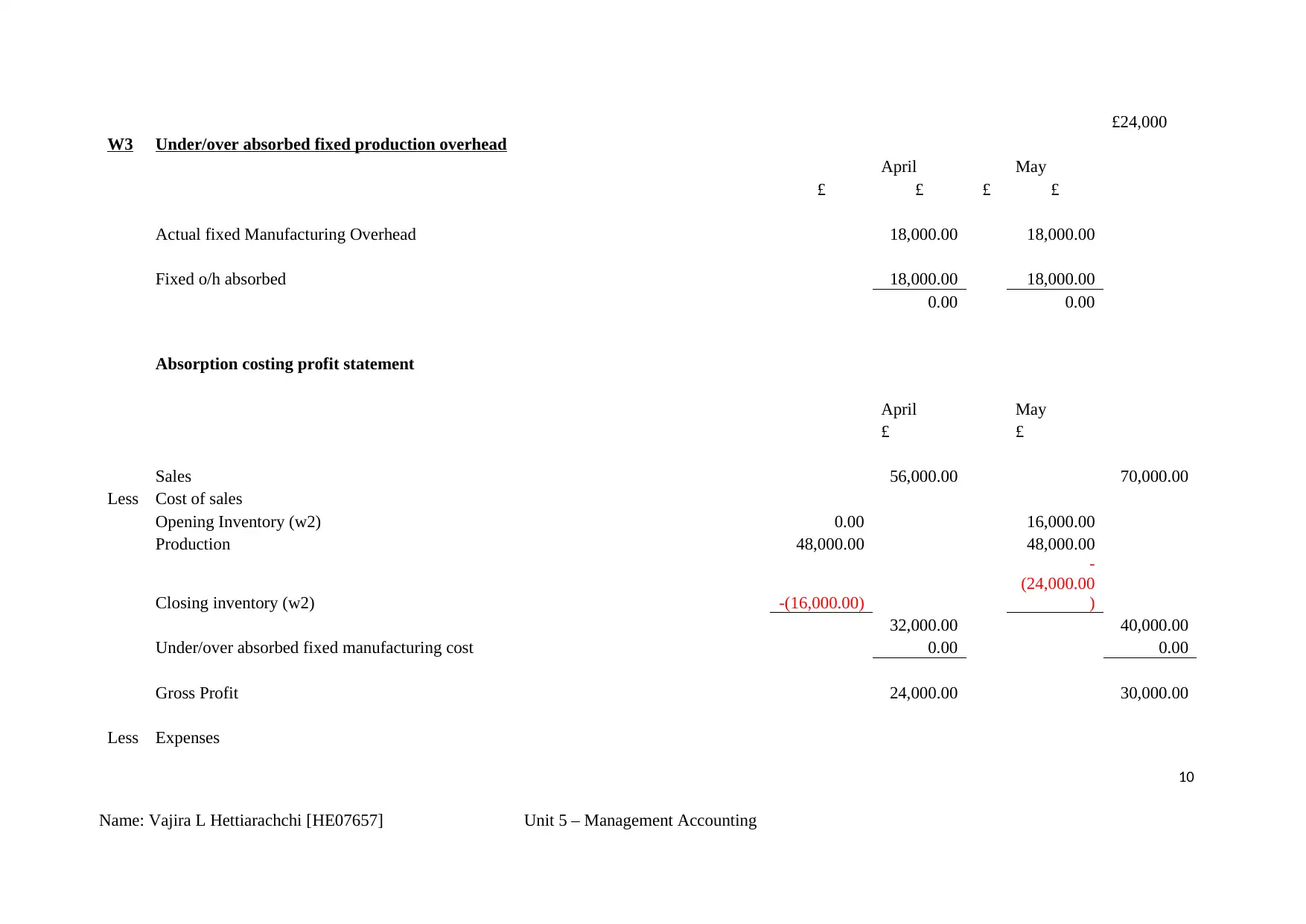
£24,000
W3 Under/over absorbed fixed production overhead
April May
£ £ £ £
Actual fixed Manufacturing Overhead 18,000.00 18,000.00
Fixed o/h absorbed 18,000.00 18,000.00
0.00 0.00
Absorption costing profit statement
April May
£ £
Sales 56,000.00 70,000.00
Less Cost of sales
Opening Inventory (w2) 0.00 16,000.00
Production 48,000.00 48,000.00
Closing inventory (w2) -(16,000.00)
-
(24,000.00
)
32,000.00 40,000.00
Under/over absorbed fixed manufacturing cost 0.00 0.00
Gross Profit 24,000.00 30,000.00
Less Expenses
Name: Vajira L Hettiarachchi [HE07657] Unit 5 – Management Accounting
10
W3 Under/over absorbed fixed production overhead
April May
£ £ £ £
Actual fixed Manufacturing Overhead 18,000.00 18,000.00
Fixed o/h absorbed 18,000.00 18,000.00
0.00 0.00
Absorption costing profit statement
April May
£ £
Sales 56,000.00 70,000.00
Less Cost of sales
Opening Inventory (w2) 0.00 16,000.00
Production 48,000.00 48,000.00
Closing inventory (w2) -(16,000.00)
-
(24,000.00
)
32,000.00 40,000.00
Under/over absorbed fixed manufacturing cost 0.00 0.00
Gross Profit 24,000.00 30,000.00
Less Expenses
Name: Vajira L Hettiarachchi [HE07657] Unit 5 – Management Accounting
10
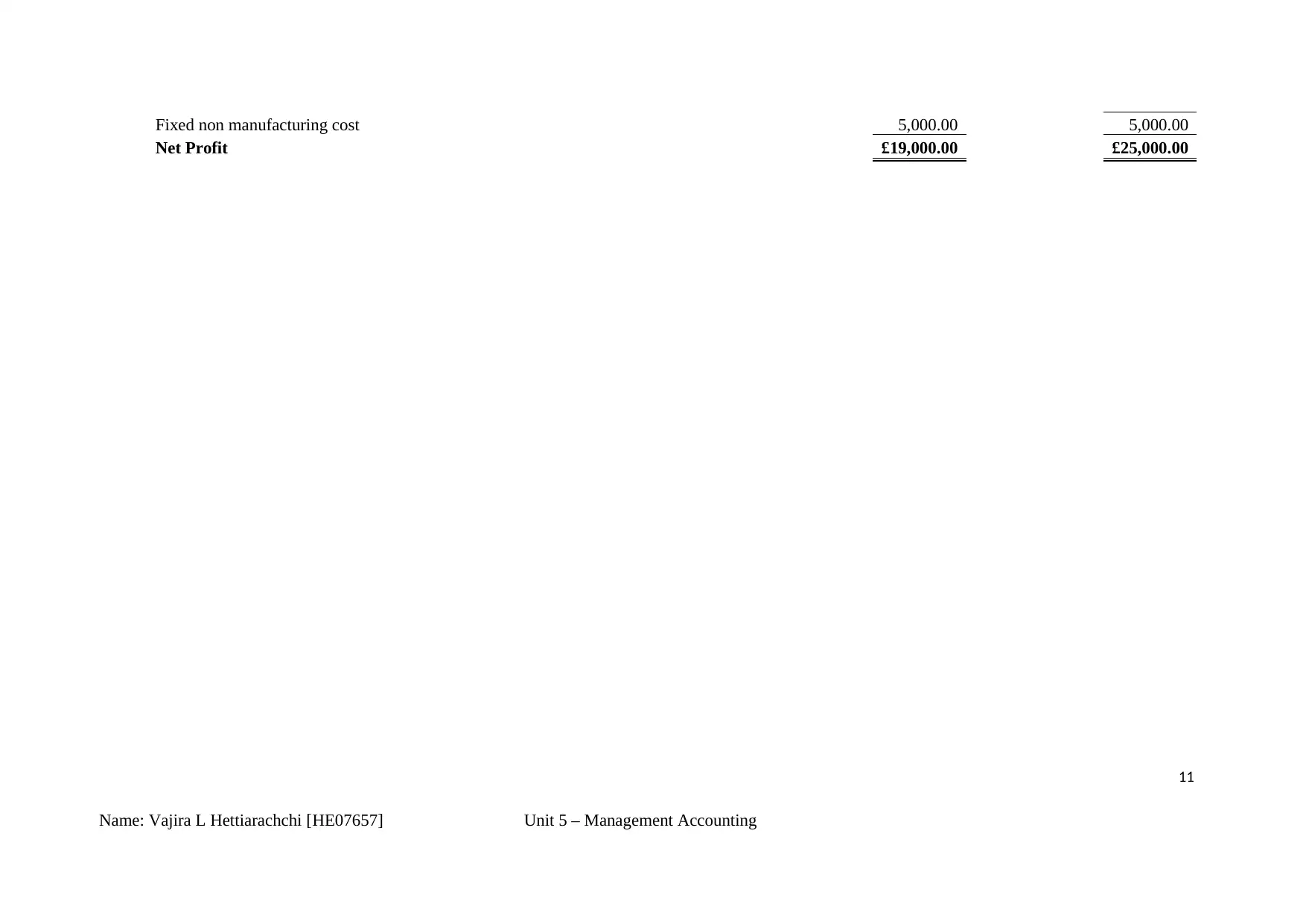
Fixed non manufacturing cost 5,000.00 5,000.00
Net Profit £19,000.00 £25,000.00
Name: Vajira L Hettiarachchi [HE07657] Unit 5 – Management Accounting
11
Net Profit £19,000.00 £25,000.00
Name: Vajira L Hettiarachchi [HE07657] Unit 5 – Management Accounting
11
⊘ This is a preview!⊘
Do you want full access?
Subscribe today to unlock all pages.

Trusted by 1+ million students worldwide
1 out of 25
Related Documents
Your All-in-One AI-Powered Toolkit for Academic Success.
+13062052269
info@desklib.com
Available 24*7 on WhatsApp / Email
![[object Object]](/_next/static/media/star-bottom.7253800d.svg)
Unlock your academic potential
Copyright © 2020–2025 A2Z Services. All Rights Reserved. Developed and managed by ZUCOL.



